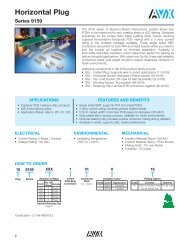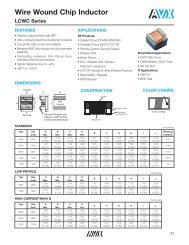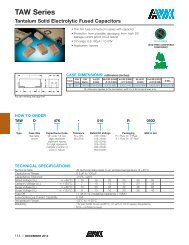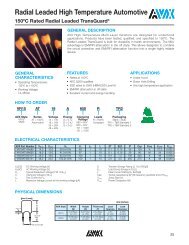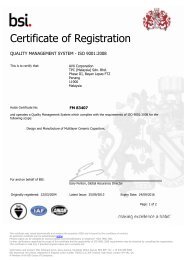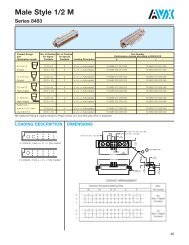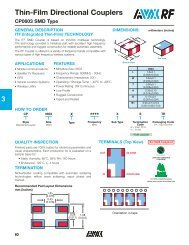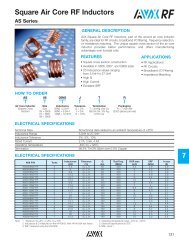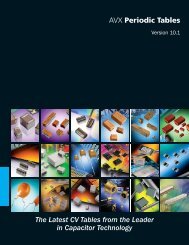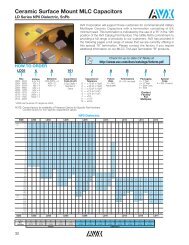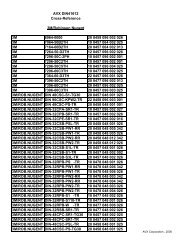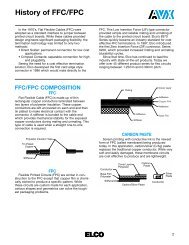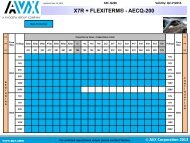TECHNICAL INFORMATION - AVX
TECHNICAL INFORMATION - AVX
TECHNICAL INFORMATION - AVX
You also want an ePaper? Increase the reach of your titles
YUMPU automatically turns print PDFs into web optimized ePapers that Google loves.
2. Several materials listed in this table are only<br />
experimental and are utilized for understanding<br />
the thermal shock behavior.<br />
TABLE 2<br />
TEMP. BASE MINOR FLUX<br />
CERAMIC DESIG. COMPOSITION ADDITIVES K 1C, CERAMIC<br />
A NP0 RARE EARTH OXIDE YES 1.4<br />
B NP0 MAGNESIUM TITANATE NO 1.5<br />
C X7R BARIUM TITANATE YES 1.1<br />
D X7R BARIUM TITANATE YES 1.2<br />
E X7R BARIUM TITANATE NO 0.6-0.8<br />
F Z5U BARIUM TITANATE NO 0.85<br />
G Z5U BARIUM TITANATE NO —<br />
B. Design Considerations<br />
Samples were prepared from ceramics ‘A’<br />
through ‘F’ (listed in Table 2) to study the effects<br />
of design changes in the 1206 size MLCs. This was<br />
done by changing the number and placement of<br />
electrode layers while the overall chip thickness<br />
was held constant. Both bridged designs,<br />
where the electrode stack is separated by a thick<br />
ceramic layer in the middle referred to as a<br />
“bridge”, and non-bridged designs were utilized to<br />
make the chips. MLCs (1206 size) were also made<br />
with electrode thicknesses of 3.3m and 5.5m by<br />
using different screen mesh sizes.<br />
C. Effect of Chip Thickness<br />
Since thermal stresses are known to change as a<br />
function of the square of unit thickness and are also<br />
dependent on the coefficient of thermal expansion,<br />
chips were prepared with varying thicknesses from<br />
0.38mm to 1.52mm for 1206, 1210 and 1812 size chips<br />
from ceramic D using non-bridged designs only.<br />
D. Effect of Dielectric Thickness<br />
As mentioned earlier, these devices are really<br />
metal-ceramic composites and varying the dielectric<br />
thickness should change the effective thermal<br />
conductivity and therefore the stress gradients<br />
in these chips. This effect was studied by preparing<br />
1210 size chips using ceramic D with constant cover<br />
layer and overall thicknesses, but varying dielectric<br />
thicknesses from 25 to 229 microns.<br />
E. Effect of Termination<br />
Another technique to change the thermal<br />
stresses and stress gradients is to utilize different<br />
types of terminations like Pd/Ag alloys or silver<br />
which is plated with nickel and a 90Sn/10Pb<br />
solder coating. The nickel thickness during the<br />
plating process is maintained at 2.0 ± 0.5 microns<br />
except for experiments where the effect of plating<br />
thickness of Ni was evaluated and the average<br />
thickness was varied from 1.5 to 18.4 microns.<br />
F. Role of Flaws<br />
Samples with various flaws like delaminations<br />
or cracks identified in chips prepared with<br />
ceramic G were tested for thermal shock resistance<br />
where thirteen groups with varying degree<br />
of flaws were studied.<br />
G. Thermal Stress Resistance and Wave Solder<br />
Conditions<br />
Of the four basic soldering processes (hot air<br />
reflow, infrared reflow, vapor phase reflow and wave<br />
soldering), it appears that wave soldering results in<br />
the largest temperature gradients and therefore the<br />
largest stress gradients. To simulate this process,<br />
two test conditions were utilized to evaluate chips<br />
studied in experimental procedures (A) through (F).<br />
In the first test condition (known as the solder dip<br />
test), chips were picked with metal tweezers along<br />
the ceramic edges of the chip and dipped in<br />
60Sn/40Pb solder at 260° and/or 425°C with no preheat<br />
such that either of the termination ends enters<br />
the solder and the chip is vertical. The tweezer is<br />
dipped in chloroethane, VG after each test to keep<br />
the tweezer at room temperature. In the second<br />
case, the chips were mounted on a board and a wave<br />
soldering temperature of 260°C was used. The wave<br />
soldering technique was further evaluated and setup<br />
parameters like the preheat and the speed of the<br />
board through the preheat and into the solder wave<br />
were varied. In all these cases, the chips were visually<br />
examined for cracks and these results are<br />
reported and discussed below. Several lots were also<br />
sectioned and polished to examine differences<br />
between external visual cracks and internal cracks<br />
and it was found that in general most cracks<br />
emerged at the surface. Correlation between various<br />
samples considering combined internal and<br />
external cracks, and only external cracks were found<br />
to be similar in behavior. For this reason, only external<br />
cracks were utilized in subsequent experiments.<br />
These results are reported and discussed below.<br />
III. Results and Discussion<br />
The various experiments listed above are now discussed<br />
in the following paragraphs.<br />
A. Behavior of Ceramic Dielectrics<br />
As indicated earlier, various ceramic dielectric<br />
materials behave quite differently under similar<br />
thermal shock experiments. Dielectric compositions<br />
classified by their temperature coefficients as NP0,<br />
X7R and Z5U were utilized to prepare 1206 size<br />
chips with various active layers and overall thicknesses<br />
of 0.85mm and 1.15mm, respectively. The<br />
results of the solder dip test of parts dipped in<br />
60Sn/40Pb solder at 260°C did not show any visual<br />
cracks. To study differences in the various ceramic<br />
materials, parts with Pd/Ag terminations were<br />
dipped in 60Sn/40Pb solder at 425°C with no preheat<br />
and the results are shown in Table 3. The<br />
results show:



